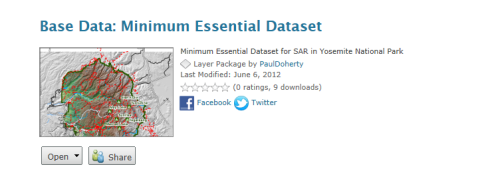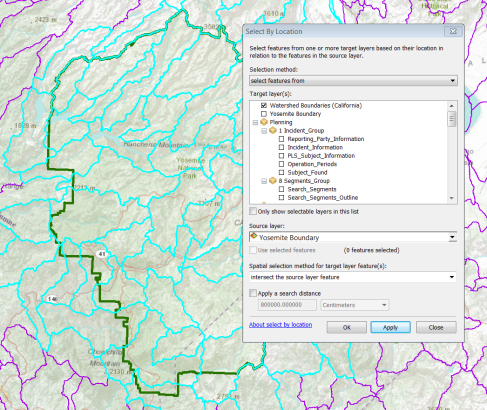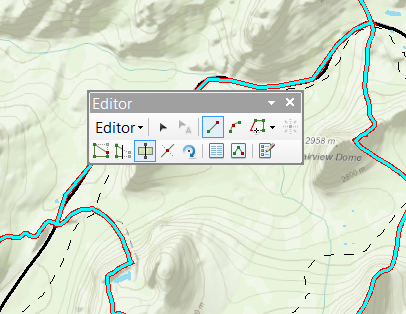 |
| Now what? |
Lorri Peltz-Lewis (USFS), Kathy Hansen (NPS), George Durkee (NPS), Tim Smith (NPS), Kevin Davis (NPS), Edan Cain (Esri), Bernie Szukalksi (Esri), Ian Batley (Mapping and Planning Support Team - MAPS), the Open Street Map Team, Don Ferguson (IGT4SAR) and Jon Pedder & Arnold Gaffrey (Sierra Madre SAR) have all pitched in and shared their ideas. So I thought I would compile these here. Thank you all for your comments!
Downloading
There are many options, but I thought I'd list the ones that were most recently discussed. Most of the SAR Teams I have worked with use Garmin GPS - but the bottom line is any GPS Receiver / smartphone should be able to create gpx files which are inter-operable with the solutions discussed here as well as proprietary software like Terrain Nav Pro, Maptech, etc.
- DNR Garmin is free and has been used by Wildland Fire GISS for many years. It has a small learning curve but allows for direct connect to GPS and directly imports / exports to ArcMap. This is still the best option, in my opinion. Here is a short video by George Durke.
- GPS Babel is also free and does everything DNR Garmin does and more... steeper learning curve for sure
- Garmin Basecamp free and easier to use than most other GUI I have seen. Obviously only works to connect with Garmin units. This may be the best solution when you want to split GPS / GIS tasks and are limited on GIS trained staff.
- ArcGIS Explorer - Edan built this tool a long time ago and ArcGIS Explorer has native GPS support in it's final release AGX 2500.
- [Updated] Open Street Map is another way to map your GPS tracks and also contribute to basemaps that work across platforms, including ArcGIS Online and ArcGIS Desktop. Download the ArcGIS Add-in to download vector data and work disconnected with this resource: ArcGIS Editor for OSM.
- [Updated] EasyGPS I have not used this yet but it looks promising and has good reviews from our 'mates down under. The website says "EasyGPS is the fast and easy way to upload and download waypoints, routes, and tracks between your Windows computer and your Garmin, Magellan, or Lowrance GPS. EasyGPS lists all of your waypoints on the left side of the screen, and shows a plot of your GPS data on the right. Use EasyGPS to back up and organize your GPS data, print maps, or load new waypoints onto your GPS for your next hike or geocaching adventure. EasyGPS works with every popular handheld GPS receiver, and it is 100% FREE!"
- ArcGIS Online this is actually very easy to use but NOT to be used for long term GPS management and only works with an internet connection. If you are just looking for a quick GPS import or to make a mash-up with your tracks. Below is an interactive map with some of my favorite running routes.
Data Management
The MapSAR team has adapted many GPS data management techniques from the National Wildfire GIS Standard Operating Procedures - but we are open to any tips and tricks you all might have as well.
- Using GIS in WiSAR text discusses GPS data management in detail in Chapter 6: Integrating GPS and Current Technologies into SAR Operations
- Folder structure used by George Durkee - this has not been adopted as a standard but might be helpful starting point. From George "I've created a stripped down version of the MapSAR folder structure by removing the MapSAR for ArcGIS 10 files. This keeps a logical folder structure along with suggested naming conventions that Paul developed. It also includes the Excel file 2013_SAR_GIS_FILE_NAMER.xlsx Vanessa did. This customizes and standardizes file and folder naming for anything you need on a SAR. If you're not using MapSAR, the folder structure is pretty darned good for organizing not only your SAR files, but gives you an idea of how to organize all your geospatial files."
- MapSAR can connect to a GPS directly if tracks are stored on an SD card, very easy to use with Edan Cain's GPS Add-in that comes with MapSAR. Either way - once GPX files are accessible, this tool is the best way to get your data into a geodatabase. Watch video here. To export to GPS tracks - you CAN export to .kml and use software that allows .kml to the GPS receiver.
- IGT4SAR similar to MapSAR, but specific to IGT4SAR is the ability to determine a theoretical Probability of Detection from the GPS track. This provides a verification for the estimate of POD provided by the teams. IGT4SAR allows for native feature to .gpx. See comments from Don below.
- Feature to GPX Add-In (by Kevin Hibma) for ArcMap can be installed, but you need to convert polygons to line first . There is an open ArcGIS for Ideas open on the topic and you can go here to vote for it's implementation.
Training and Cheat Sheets
Since so much of what we are trying to do in SAR has already been done by the fire service - Kathy and Lorri have forwarded some more helpful resources for your team.- GPS Training from NWCG The class that Kathie Hansen developed and continues to maintain.
- GPS Pocket Cards have tip sheets for the following Garmins: MAP62, 60CS, 76CS, 76S, Montana, and Oregon If you have a Rhino it is very similar to the 62
- GPS for Download Tag George says "This form is intended for use as SAR teams turn in their GPS. You fill out the form of the team, then put it and their GPS in a plastic bag for later download and keeping track of their GPS. The team can either be debriefed or go get food. Also attached is WAYPOINT FORM_Draft2.pdf. This is for field teams to fill out when they establish a waypoint (clue, LZ etc.) etc. on their GPS. Turned in on debriefing, it allows the GIS person to know what the Wapoints are they download."
 |
| No GPS? No dinner! |
Well - this is a start. Please send more resources to the SARGIS Discussion Group and/or make comments below.





